
- •Explanation
- •1. Flash (the default location) 2. Tftp server 3. Rom (used if no other source is found)
- •Question 3
- •In a switched environment, what does the ieee 802.1q standard describe?
- •Question 8
- •Question 3
- •Vlan 3 is not yet configured on your switch. What happens if you set the switchport access vlan 3 command interface configuration mode?
- •Explanation
- •In the Frame Relay network, which ip addresses whould be assigned to the interfaces with point-to-point pvCs?
- •It has become necessary to configure an existing serial interface to accept a second Frame Relay virtual circuit. Which of the following are required to solve this? (Choose three)
- •If ip routing is enabled, which two commands set the gateway of last resort to the default gateway? (Choose two)
- •Question 8
- •Explanation
- •Explanation
- •If the startup-config file is missing or does not specify a location, it will check the following locations for the ios image:
- •Question 4
- •Explanation
- •Explanation
In a switched environment, what does the ieee 802.1q standard describe?
A. the operation of VTP B. a method of VLAN trunking C. an approach to wireless LAN communication D. the process for root bridge selection E. VLAN pruning
Answer: B
Question 3
As a network technician, do you know which are valid modes for a switch port used as a VLAN trunk? (Choose three)
A. transparent B. auto C. on D. desirable E. blocking F. forwarding
Answer: B C D
Question 4
Refer to the exhibit:
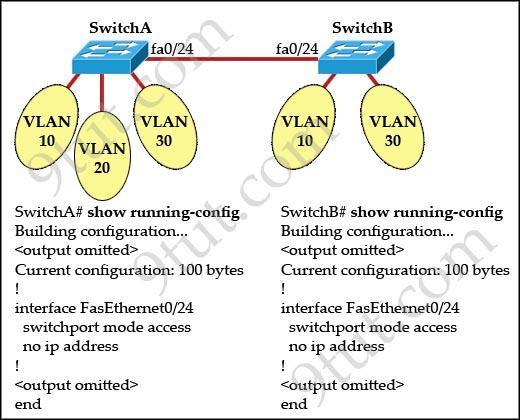
All switch ports are assigned to the correct VLANs, but none of the hosts connected to SwitchA can communicate with hosts in the same VLAN connected to SwitchB. Based on the output shown, what is the most likely problem?
A. The access link needs to be configured in multiple VLANs. B. The link between the switches is configured in the wrong VLAN C. The link between the switches needs to be configured as a trunk. D. VTP is not configured to carry VLAN information between the switches. E. Switch IP addresses must be configured in order for traffic to be forwarded between the switches.
Answer: C
Question 5
Which IEEE standard protocol is initiated as a result of successful DTP completion in a switch over FastEthernet?
A. 802.3ad B. 802.1w C. 802.1Q D. 802.1d
Answer: C
Explanation
Dynamic Trunking Protocol (DTP) is a Cisco proprietary protocol for negotiating trunking on a link between two devices and for negotiating the type of trunking encapsulation (802.1Q) to be used.
Question 6
Which three of these statements regarding 802.1Q trunking are correct? (Choose three)
A. 802.1Q native VLAN frames are untagged by default. B. 802.1Q trunking ports can also be secure ports. C. 802.1Q trunks can use 10 Mb/s Ethernet interfaces. D. 802.1Q trunks require full-duplex, point-to-point connectivity. E. 802.1Q trunks should have native VLANs that are the same at both ends.
Answer: A C E
Question 7
Refer to the exhibit:
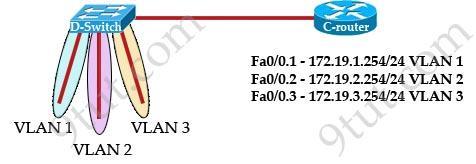
C-router is to be used as a “router-on-a-stick” to route between the VLANs. All the interfaces have been properly configured and IP routing is operational. The hosts in the VLANs have been configured with the appropriate default gateway. What can be said about this configuration?
A. These commands need to be added to the configuration: C-router(config)# router eigrp 123 C-router(config-router)# network 172.19.0.0
B. No further routing configuration is required.
C. These commands need to be added to the configuration: C-router(config)# router ospf 1 C-router(config-router)# network 172.19.0.0 0.0.3.255 area 0
D. These commands need to be added to the configuration: C-router(config)# router rip C-router(config-router)# network 172.19.0.0
Answer: B
Question 8
Refer to the exhibit:
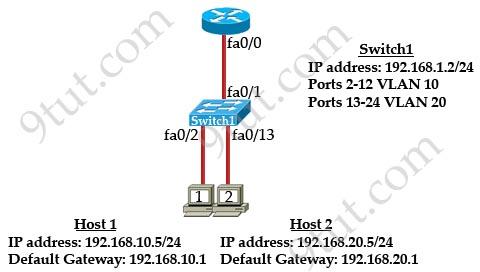
What commands must be configured on the 2950 switch and the router to allow communication between host 1 and host 2? (Choose two)
A. Router(config)#interface fastethernet 0/0 Router(config-if)#ip address 192.168.1.1 255.255.255.0 Router(config-if)#no shut down
B. Router(config)#interface fastethernet 0/0 Router(config-if)#no shutdown Router(config)#interface fastethernet 0/0.1 Router(config-subif)#encapsulation dot1q 10 Router(config-subif)#ip address 192.168.10.1 255.255.255.0 Router(config-subif)#interface fastethernet 0/0.2 Router(config-subif)#encapsulation dot1q 20 Router(config-subif)#ip address 192.168.20.1 255.255.255.0
C. Router (config)#router eigrp 100 Router(config-router)#network 192.168.10.0 Router(config-router)#network 192.168.20.0
D. Switch1(config)# vlan database Switch1(config-vlan)# vtp domain XYZ Switch1(config-vlan)# vtp server
E. Switch1(config) # interface fastEthernet 0/1 Switch1(config-if)# switchport mode trunk
F. Switch1(config)# interface vlan 1 Switch1(config-if)# ip default-gateway 192.168.1.1
Answer: B E
Question 9
Which two of these are characteristics of the 802.1Q protocol? (Choose two)
A. It is a layer 2 messaging protocol which maintains vlan configurations across network. B. It includes an 8-bit field which specifies the priority of a frame. C. It is used exclusively for tagging vlan frames and dose not address network reconvergence following switched network topology changes. D. It modifies the 802.3 frame header and thus requires that the FCS be recomputed. E. It is a trunking protocol capable of earring untagged frames.
Answer: D E
Explanation
IEEE 802.1Q is the networking standard that supports Virtual LANs (VLANs) on an Ethernet network. It is a protocol that allows VLANs to communicate with one another using a router. 802.1Q trunks support tagged and untagged frames.
If a switch receives untagged frames on a trunk port, it believes that frame is a part of the native VLAN. Also, frames from a native VLAN are not tagged when exiting the switch via a trunk port.
The 802.1q frame format is same as 802.3. The only change is the addition of 4 bytes fields. That additional header includes a field with which to identify the VLAN number. Because inserting this header changes the frame, 802.1Q encapsulation forces a recalculation of the original FCS field in the Ethernet trailer.
Note: Frame Check Sequence (FCS) is a four-octet field used to verify that the frame was received without loss or error. FCS is based on the contents of the entire frame.
Question 10
What are the possible trunking modes for a switch port? (Choose three)
A. transparent B. auto C. on D. desirable E. client F. forwarding
Answer: B C D
CCNA Trunking Questions 2
Question 1
What is the function of the command switchport trunk native vlan 999 on a trunk port?
A. It designates VLAN 999 for untagged traffic. B. It blocks VLAN 999 traffic from passing on the trunk. C. It creates a VLAN 999 interface. D. It designates VLAN 999 as the default for all unknown tagged traffic.
Answer: A
Question 2
Which three elements must be used when you configure a router interface for vlan trunking? (Choose three)
A. one IP network or subnetwork for each subinterface B. subinterface numbering that matches vlan tages C. subinterface encapsulation identifiers that match vlan tags D. a management domain for each subinterface G E. one physical interface for each subinterface F. one subinterface per vlan
Answer: A C F
Question 3
Which two link protocols are used to carry multiple VLANs over a single link? (Choose two)
A. VTP B. 802.1q C. IGP D. ISL E. 802.3u
Answer: B D
Explanation
Cisco switches support two trunking protocols 802.1q & ISL. 802.1q is an open standard and is thus compatible between most vendors’ equipment while Inter-Switch Link (ISL) is Cisco proprietary.
Question 4
Which two commands can be used to verify a trunk link configuration status on a Cisco switch? (choose two)
A. show interfaces trunk B. show interfaces switchport C. show ip interface brief D. show interfaces vlan
Answer: A B
Explanation
The “show interfaces trunk” command and “show interfaces switchport” command can be used to verify the status of an interface (trunking or not). The outputs of these commands are shown below (port Ethernet 1/0 has been configured as trunk):

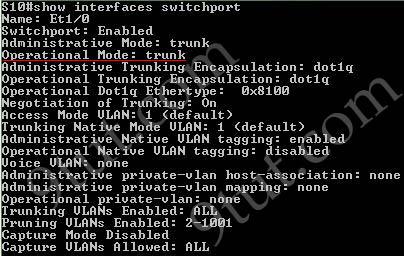
The “show ip interface brief” command only gives us information about the IP address, the status (up/down) of an interface:

The “show interfaces vlan” command only gives us information about that VLAN, not about which ports are the trunk links:
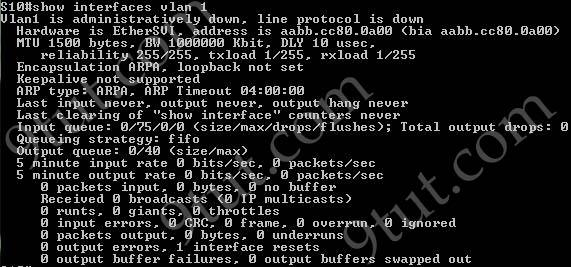
Question 5
Refer to the exhibit:
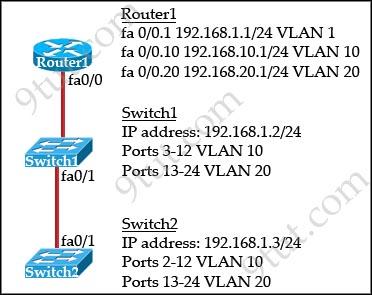
How should the FastEthernet0/1 port on the 2950 model switches that are shown in the exhibit be configured to allow connectivity between all devices?
A. The ports only need to be connected by a crossover cable.
B. SwitchX (config)#interface FastEthernet 0/1 SwitchX(config-if)#switchport mode trunk
C. SwitchX (config)#interface FastEthernet 0/1 SwitchX(config-if)#switchport mode access SwitchX(config-if)#switchport access vlan 1
D. SwitchX (config)#interface FastEthernet 0/1 SwitchX(config-if)#switchport mode trunk SwitchX(config-if)#switchport trunk vlan 1 SwitchX(config-if)#switchport trunk vlan 10 SwitchX(config-if)#switchport trunk vlan 20
Answer: B
CCNA STP
Question 1
Refer to the topology shown in the exhibit. Which ports will be STP designated ports if all the links are operating at the same bandwidth? (Choose three)
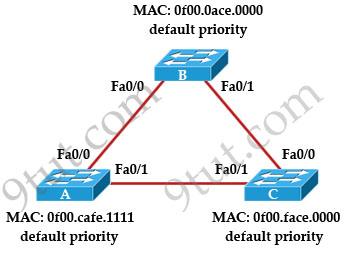
A. Switch A – Fa0/0 B. Switch A – Fa0/1 C. Switch B – Fa0/0 D. Switch B – Fa0/1 E. Switch C – Fa0/0 F. Switch C – Fa0/1
Answer: B C D
Explanation
First by comparing their MAC addresses we learn that switch B will be root bridge as it has lowest MAC. Therefore all of its ports are designated ports -> C & D are correct.
On the link between switch A & switch C there must have one designated port and one non-designated (blocked) port. We can figure out which port is designated port by comparing their MAC address again. A has lower MAC so Fa0/1 of switch A will be designated port while Fa0/1 of switch C will be blocked -> B is correct.
Question 2
What value is primarily used to determine which port becomes the root port on each non-root switch in a spanning-tree topology?
A. lowest port MAC address B. port priority number and MAC address. C. VTP revision number D. highest port priority number. E. path cost
Answer: E
Explanation
The path cost to the root bridge is the most important value to determine which port will become the root port on each non-root switch. In particular, the port with lowest cost to the root bridge will become root port (on non-root switch).
Question 3
What is one benefit of PVST+?
A. PVST+ reduces the CPU cycles for all the switches in the network. B. PVST+ automatically selects the root bridge location, to provide optimization. C. PVST+ allows the root switch location to be optimized per vlan. D. PVST+ supports Layer 3 load balancing without loops.
Answer: C
Explanation
Per VLAN Spanning Tree (PVST) maintains a spanning tree instance for each VLAN configured in the network. It means a switch can be the root bridge of a VLAN while another switch can be the root bridge of other VLANs in a common topology. For example, Switch 1 can be the root bridge for Voice data while Switch 2 can be the root bridge for Video data. If designed correctly, it can optimize the network traffic.
Question 4
Which two protocols are used by bridges and/or switches to prevent loops in a layer 2 network? (Choose two)
A. 802.1d B. VTP C. 802.1q D. STP E. SAP
Answer: A D
Question 5
In which circumstance are multiple copies of the same unicast frame likely to be transmitted in a switched LAN?
A. after broken links are re-established B. in an improperly implemented redundant topology C. when upper-layer protocols require high reliability D. during high traffic periods E. when a dual ring topology is in use
Answer: B
Explanation
If we connect two switches via 2 or more links and do not enable STP on these switches then a loop (which creates multiple copies of the same unicast frame) will occur. It is an example of an improperly implemented redundant topology.
Question 6
Refer to the exhibit.
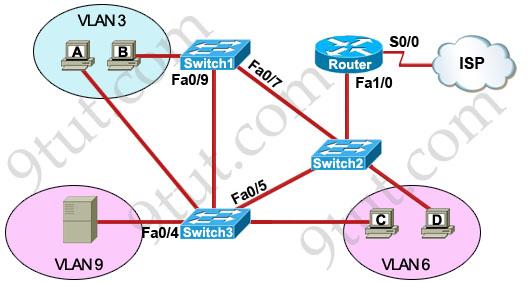
A problem with network connectivity has been observed. It is suspected that the cable connected to switch port Fa0/9 on Switch1 is disconnected. What would be an effect of this cable being disconnected?
A. Host B would not be able to access the server in VLAN9 until the cable is reconnected. B. Communication between VLAN3 and the other VLANs would be disabled. C. The transfer of files from Host B to the server in VLAN9 would be significantly slower. D. For less than a minute, Host B would not be able to access the server in VLAN9. Then normal network function would resume.
Answer: D
Question 7
Which port state is introduced by Rapid-PVST?
A. learning B. listening C. discarding D. forwarding
Answer: C
Explanation
PVST+ is based on IEEE802.1D Spanning Tree Protocol (STP). But PVST+ has only 3 port states (discarding, learning and forwarding) while STP has 5 port states (blocking, listening, learning, forwarding and disabled). So discarding is a new port state in PVST+.
Question 8
Refer to the exhibit. Based on the information given, which switch will be elected root bridge and why?
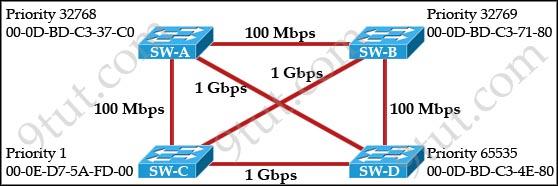
A. Switch A, because it has the lowest MAC address B. Switch A, because it is the most centrally located switch C. Switch B, because it has the highest MAC address D. Switch C, because it is the most centrally located switch E. Switch C, because it has the lowest priority F. Switch D, because it has the highest priority
Answer: E
Question 9
Which term describes a spanning-tree network that has all switch ports in either the blocking or forwarding state?
A. redundant B. spanned C. provisioned D. converged
Answer: D
Explanation
Spanning Tree Protocol convergence (Layer 2 convergence) happens when bridges and switches have transitioned to either the forwarding or blocking state. When layer 2 is converged, root bridge is elected and all port roles (Root, Designated and Non-Designated) in all switches are selected.
Question 10
Refer to the exhibit. Given the output shown from this Cisco Catalyst 2950, what is the most likely reason that interface FastEthernet 0/10 is not the root port for VLAN 2?
Switch# show spanning-tree interface fastethernet0/10

A. This switch has more than one interface connected to the root network segment in VLAN 2. B. This switch is running RSTP while the elected designated switch is running 802.1d Spanning Tree. C. This switch interface has a higher path cost to the root bridge than another in the topology. D. This switch has a lower bridge ID for VLAN 2 than the elected designated switch.
Answer: C
CCNA STP 2
Question 1
Three switches are connected to one another via trunk ports. Assuming the default switch configuration, which switch is elected as the root bridge for the spanning-tree instance of VLAN 1?
A. the switch with the highest MAC address B. the switch with the lowest MAC address C. the switch with the highest IP address D. the switch with the lowest IP address
Answer: B
Question 2
Based on the network shown in the graphic
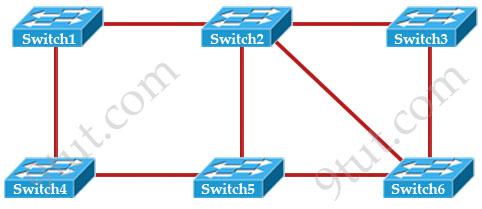
Which option contains both the potential networking problem and the protocol or setting that should be used to prevent the problem?
A. routing loops, hold down timers B. Switching loops, split horizon C. routing loops, split horizon D. Switching loops, VTP E. routing loops, STP F. Switching loops, STP
Answer: F
Question 3
Refer to the exhibit. Which switch provides the spanning-tree designated port role for the network segment that services the printers?
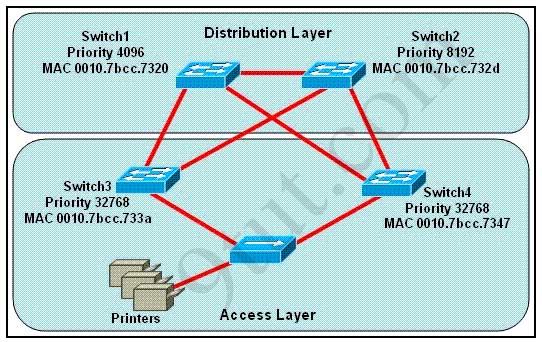
A. Switch1 B. Switch2 C. Switch3 D. Switch4
Answer: C
Explanation
First, the question asks what switch services the printers, so it can be Switch 3 or Switch 4 which is connected directly to the Printers.
Next, by comparing the MAC address of Switch 3 and Switch 4 we found that the MAC of Switch 3 is smaller. Therefore the interface connected to the Printers of Switch 3 will become designated interface and the interface of Switch 4 will be blocked. (Please notice that Switch 1 will become the root bridge because of its lowest priority, not Switch 3)
CCNA RSTP
Question 1
Which three statements about RSTP are true? (Choose three)
A. RSTP significantly reduces topology reconvening time after a link failure. B. RSTP expands the STP port roles by adding the alternate and backup roles. C. RSTP port states are blocking, discarding, learning, or forwarding. D. RSTP provides a faster transition to the forwarding state on point-to-point links than STP does. E. RSTP also uses the STP proposal-agreement sequence. F. RSTP uses the same timer-based process as STP on point-to-point links.
Answer: A B D
Question 2
Refer to the exhibit:
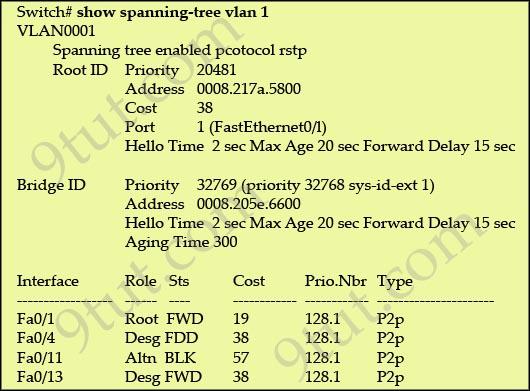
Why has this switch not been elected the root bridge for VLAN1?
A. It has more than one internee that is connected to the root network segment. B. It is running RSTP while the elected root bridge is running 802.1d spanning tree. C. It has a higher MAC address than the elected root bridge. D. It has a higher bridge ID than the elected root bridge.
Answer: D
Explanation
As we can see from the output above, the priority of the root bridge is 20481 while that of the local bridge is 32769.
Question 3
Which command enables RSTP on a switch?
A. spanning-tree mode rapid-pvst B. spanning-tree uplinkfast C. spanning-tree backbonefast D. spanning-tree mode mst
Answer: A
Question 4
Refer to the exhibit. Which statement is true?

A. The Fa0/11 role confirms that SwitchA is the root bridge for VLAN 20. B. VLAN 20 is running the Per VLAN Spanning Tree Protocol. C. The MAC address of the root bridge is 0017.596d.1580. D. SwitchA is not the root bridge, because not all of the interface roles are designated.
Answer: D
Explanation
Only non-root bridge can have root port. Fa0/11 is the root port so we can confirm this switch is not the root bridge -> A is not correct.
From the output we learn this switch is running Rapid STP, not PVST -> B is not correct.
0017.596d.1580 is the MAC address of this switch, not of the root bridge. The MAC address of the root bridge is 0017.596d.2a00 -> C is not correct.
All of the interface roles of the root bridge are designated. SwitchA has one Root port and 1 Alternative port so it is not the root bridge -> D is correct.
Question 5
Refer to the exhibit. The output that is shown is generated at a switch. Which three of these statements are true? (Choose three)

A. All ports will be in a state of discarding, learning or forwarding. B. Thirty VLANs have been configured on this switch. C. The bridge priority is lower than the default value for spanning tree. D. All interfaces that are shown are on shared media. E. All designated ports are in a forwarding state. F. The switch must be the root bridge for all VLANs on this switch.
Answer: A C E
Explanation
From the output, we see that all ports are in Designated role (forwarding state) -> A and E are correct.
The command “show spanning-tree vlan 30″ only shows us information about VLAN 30. We don’t know how many VLAN exists in this switch -> B is not correct.
The bridge priority of this switch is 24606 which is lower than the default value bridge priority 32768 -> C is correct.
All three interfaces on this switch have the connection type “p2p”, which means Point-to-point environment – not a shared media -> D is not correct.
The only thing we can specify is this switch is the root bridge for VLAN 3o but we can not guarantee it is also the root bridge for other VLANs -> F is not correct.
Question 6
Which two states are the port states when RSTP has converged? (choose two)
A. blocking B. learning C. disabled D. forwarding E. listening
Answer: A D
Explanation
RSTP only has 3 port states that are discarding, learning and forwarding. When RSTP has converged there are only 2 port states left: discarding and forwarding but the answers don’t mention about discarding state so blocking state (answer A) may be considered the best alternative answer.
Question 7
Which two of these statements regarding RSTP are correct? (Choose two)
A. RSTP cannot operate with PVST+. B. RSTP defines new port roles. C. RSTP defines no new port states. D. RSTP is a proprietary implementation of IEEE 802.1D STP. E. RSTP is compatible with the original IEEE 802.1D STP.
Answer: B E
Question 8
Refer to the exhibit. Each of these four switches has been configured with a hostname, as well as being configured to run RSTP. No other configuration changes have been made. Which three of these show the correct RSTP port roles for the indicated switches and interfaces? (Choose three)
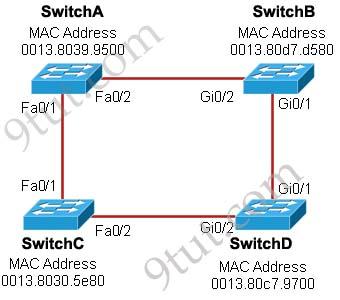
A. SwitchA, Fa0/2, designated B. SwitchA, Fa0/1, root C. SwitchB, Gi0/2, root D. SwitchB, Gi0/1, designated E. SwitchC, Fa0/2, root F. SwitchD, Gi0/2, root
Answer: A B F
Question 9
Refer to the exhibit. At the end of an RSTP election process, which access layer switch port will assume the discarding role?
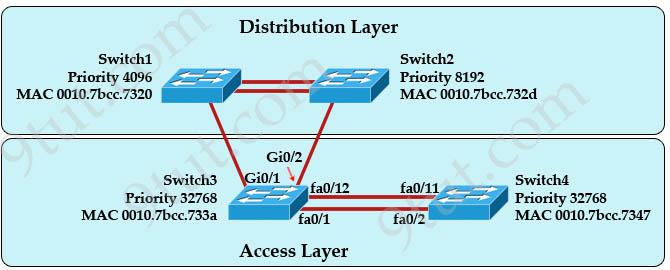
A. Switch3, port fa0/1 B. Switch3, port fa0/12 C. Switch4, port fa0/11 D. Switch4, port fa0/2 E. Switch3, port Gi0/1
Answer: C
Explanation
In this question, we only care about the Access Layer switches (Switch3 & 4). Switch 3 has a lower bridge ID than Switch 4 (because the MAC of Switch3 is smaller than that of Switch4) so both ports of Switch3 will be in forwarding state. The alternative port will surely belong to Switch4.
Switch4 will need to block one of its ports to avoid a bridging loop between the two switches. But how does Switch4 select its blocked port? Well, the answer is based on the BPDUs it receives from Switch3. A BPDU is superior than another if it has:
1. A lower Root Bridge ID 2. A lower path cost to the Root 3. A lower Sending Bridge ID 4. A lower Sending Port ID
These four parameters are examined in order. In this specific case, all the BPDUs sent by Sswitch3 have the same Root Bridge ID, the same path cost to the Root and the same Sending Bridge ID. The only parameter left to select the best one is the Sending Port ID (Port ID = port priority + port index). In this case the port priorities are equal because they use the default value, so Switch4 will compare port index values, which are unique to each port on the switch, and because Fa0/12 is inferior to Fa0/1, Switch4 will select the port connected with Fa0/1 (of Switch3) as its root port and block the other port -> Port fa0/11 of Switch4 will be blocked (discarding role).
CCNA Access List Questions
Question 1
Which item represents the standard IP ACL?
A. access-list 50 deny 192.168.1.1 0.0.0.255 B. access-list 110 permit ip any any C. access-list 2500 deny tcp any host 192.168.1.1 eq 22 D. access-list 101 deny tcp any host 192.168.1.1
Answer: A
Explanation
The standard access lists are ranged from 1 to 99 and from 1300 to 1999 so only access list 50 is a standard access list.
Question 2
A network administrator is configuring ACLs on a Cisco router, to allow traffic from hosts on networks 192.168.146.0, 192.168.147.0, 192.168.148.0, and 192.168.149.0 only. Which two ACL statements, when combined, would you use to accomplish this task? (Choose two)
A. access-list 10 permit ip 192.168.146.0 0.0.1.255 B. access-list 10 permit ip 192.168.147.0 0.0.255.255 C. access-list 10 permit ip 192.168.148.0 0.0.1.255 D. access-list 10 permit ip 192.168.149.0 0.0.255.255 E. access-list 10 permit ip 192.168.146.0 0.0.0.255 F. access-list 10 permit ip 192.168.146.0 255.255.255.0
Answer: A C
